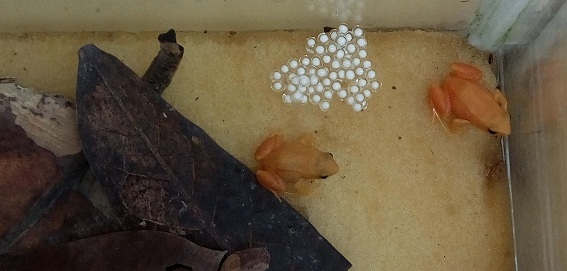Between October and November 2020, substantial progress was made towards achiveing the ob- jectives of the amphibian captive breeding at ASA partner Mitsinjo research center. In total, there are currently more than 150 terraria occupied with 11 common species and 1 Critically Endangered species. All frog species are active and are in breeding season. Even in captivity, all captive bred have adapted to this season.
Over the past two months, we have also produced a new generation of the Golden Mantella Frog (Mantella aurantiaca). By the end of Novem- ber, we have saved 45 egg clutches, with 300 tadpoles already in the water. These will be reintroduced into the wild between March and April, 2021.
Species monitored in captivity 90% of those individuals previously caught in the wild are old and need
to be changed in the next few years to prevent mortality. Even though some species bred with lower fertil- ity rates during this breeding sea- son, all the captive species are again selected for husbandry by using/ improving new technics. They are based on the tree Frog, the top hill species and, of course, the Golden Mantella Frog, which have been prepared for the next release. With regard to the next generations, we have found some clutches from F2, but these are not fertile. When this happens, Mitsinjo’s technician find a way to improve this F2 husbandry to produce F3 for the various frog species kept in the center.
The success of captive breeding depends on being able to provide the necessities for the species. Live food cultures, such as insect production, play important roles for these amphibian species. We expanded the production of our living food cultures every week. We would also like to improve other living food husbandry cultures such as termites, isopod and other insect (larvae), since these would be the best food sources for some frog species, as mentioned in our previous article in the Frogress Report.
Problems and concerns
Financial resources are some of the greatest needs to improve our activities and personnel who are in charge of the captive breeding program. Since 2011 until now, we have not received advice, technical sup- port or field training from the ASG Madagascar. Moreover, it has also become difficult to receive permits from the Malagasy government.
Recommendations
We will present these concerns to all stakeholders, for the stability of the captive breeding program in Madagascar, which is the first of its kind.
By Justin Claude Rakotoarisoa, Association Mitsinjo (Madagascar)
Photo: Justin Claude

